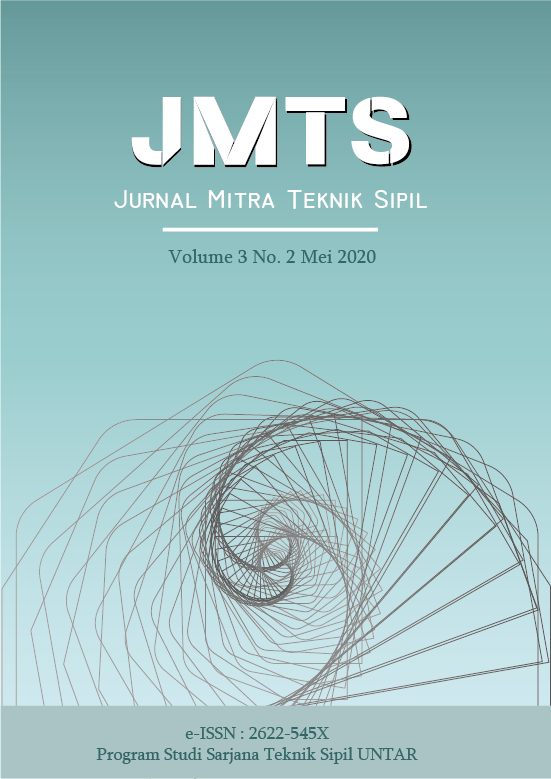PEMAHAMAN MASYARAKAT DAN PARA PEMANGKU KEPENTINGAN TERHADAP KONSEP TRANSIT ORIENTED DEVELOPMENT
Main Article Content
Abstract
There are still many people who prefer to use private vehicles than to use public transportation. One way to reduce people's dependence on the use of private motorized vehicles is by applying the concept of Transit Oriented Development (TOD). But the application of the existing TOD concept is still not accordance with the actual concept so that the benefits of the TOD concept cannot optimally gained. Therefore, this study tries to review the level of understanding of students (Civil Engineering, Architecture, and Regional and City Planning), academics (Civil Engineering, Architecture, and Regional and City Planning), and regulators of the TOD concept. This research was conducted using a questionnaire consisting of open questions and questions with a likert scale. Data were analyzed using the one-sample t test method on likert scale questions to find out respondents 'understanding of the TOD concept and paired sample test methods to determine the consistency of respondents' understanding of open questions and likert scale questions. Based on the results of the study, it was found that student respondents had the lowest understanding of the TOD concept. While the academic respondents and regulator respondents have a fairly good understanding of the TOD concept.
Abstrak
Masih banyak masyarakat yang lebih memilih untuk menggunakan kendaraan pribadi dibandingkan dengan transportasi umum. Salah satu cara mengurangi ketergantungan masyarakat terhadap penggunaan kendaraan bermotor pribadi dengan menerapkan konsep Transit Oriented Development (TOD). Tetapi penerapan konsep TOD yang ada saat ini masih ada yang kurang sesuai dengan konsep sesungguhnya sehingga manfaat dari konsep TOD tidak dapat dirasakan secara maksimal. Oleh karena itu, penelitian ini mencoba untuk meninjau tingkat pemahaman mahasiswa (Teknik Sipil, Arsitektur, dan Perencanaan Wilayah dan Kota), akademisi (Teknik Sipil, Arsitektur, dan Perencanaan Wilayah dan Kota), dan regulator terhadap konsep TOD. Penelitian ini dilakukan dengan menggunakan kuesioner yang terdiri dari pertanyaan terbuka dan pertanyaan dengan skala likert. Data dianalisis menggunakan metode one-sample t test pada pertanyaan dengan skala likert untuk mengetahui pemahaman responden tentang konsep TOD dan metode paired sample test untuk mengetahui konsistensi pemahaman responden pada pertanyaan terbuka dan pertanyaan dengan skala likert. Berdasarkan hasil penelitian, didapatkan bahwa responden mahasiswa memiliki pemahaman tentang konsep TOD yang paling rendah. Sedangkan responden akademisi dan responden regulator memiliki pemahaman tentang konsep TOD yang cukup baik.
Article Details
References
Center for Climate and Energy Solutions. Energy Use Transportation, https://www.c2es.org/2016/06/transportation-emissions-roll-over-power-sector-emissions/, (Diakses pada tanggal 2 Januari 2019)
Duncan, Michael. “Would the replacement of park-and-ride facilities with transit-oriented development reduce vehicle kilometers traveled in an auto-oriented US region.” Transport Policy, vol. 81, 2017, pp. 293-301.
Ewing, Reid, et al. “Trip and parking generation at transit-oriented developments: Five US case studies.” Lanscape and Urban Planning, vol. 160, 2017, pp. 69-78.
Guthrie, Andrew,et al. “Developers' perspectives on transit-oriented development.” Transport Policy, vol. 51, 2016, pp. 103-114.
Kamruzzaman, Md, et al. “Investigating the urban heat island effect of transit oriented development in Brisbane.” Journal of Transport Geography, vol. 66, 2018, pp. 116-124.
Kementrian Perhubungan Sekretariat Jendral Satuan Kerja Biro Perencanaan. Penyusun Rencana Induk Transportasi Nasional Tahun Anggaran 2019. 2019, Jakarta
Noland, R.B, et al. “Attitudes towards transit-oriented development-Resident experiences and professional perspectives.” Journal of Transport Geography, vol. 60, 2017, pp. 130-140.
Pan, Haixiao, et al. “What determines rail transit passenger volume Implications for transit oriented development planning.” Transportation Research Part D, vol. 57, 2017, pp. 52-63.
Peraturan Menteri Agraria dan Tata Ruang/Kepala Badan Pertahanan Nasional Republik Indonesia Nomor 16 Tahun 2017 tentang Pedoman Pengembangan Kawasan Berorientasi Transit atau Transit Oriented Development


